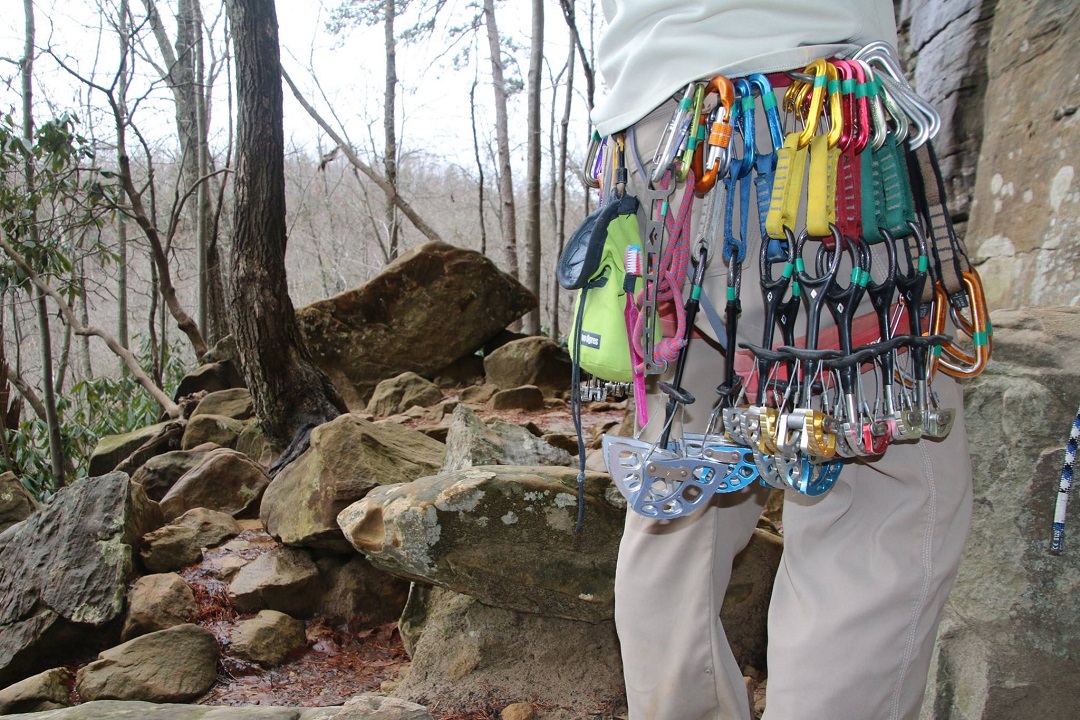For most rock climbers, the content of their gear bag evolves akin to their skills. From rentals to racks, the ever-advancing climber is bombarded with options. Here’s a look at the equipment you should consider adding as you level up your climbing game.
Level: First time
Gear: Rentals
Cost: $25-$30 (day pass + rentals)
Indoor rock-climbing gyms are designed for every skill level and equipped with the gear needed to scale their color-coded walls. Simply show up to any of the local gyms, and a team member will fit you for a harness and shoe rental.
Level: New hobby
Gear: Shoes
Cost: $90-$170
Quick is the passage from first-time to all-the-time climber. Quicker yet to ditch the rentals. Luckily, a basic collection of rock-climbing gear mimics the set you’ve been renting — harness, belay device, chalk bag, and shoes.

A basic rock-climbing setup. (Upper Limits)
“Purchasing a pair of climbing shoes is probably the best investment a climber can make,” said Jess White, operations and retail at Climb So iLL.
A beginner shoe is shaped more like a sneaker (neutral) than an upside-down letter U (aggressive) and fits snuggly and somewhat comfortably.
“A snug fit creates one point of power. Climbers step on extremely small foot grips, so having that central point is essential,” White said.
Level: Sport climb
Gear: Rope
Cost: $150-$400
Trading the security of a top rope for the thrill of connecting one fixed protection point to the next takes commitment and the right rope for the journey. A dynamic rope stretches when weighted and is non-negotiable; otherwise, there are options galore.
“The two biggest considerations are length and diameter,” said Avery Evans, sales associate at REI St. Louis. “A thinner rope is lighter but less durable. As for length, it should be twice that of the route.”
A standard, single rope is 60 or 70 meters in the mid-to-upper 9mm range. Depending on its use, a shorter gym rope or burlier workhorse (9.8mm to 10.2mm) may be better suited.
Around here, sport climbers frequently learn the basics in a gym, where quickdraws are pre-placed and top anchors are permanent. Consequently, the gym-to-crag transition demands both skills and gear not needed indoors. Now is when gear bags get beefier, with the addition of slings, locking and non-locking carabiners, a rappel device, and quickdraws.
“Quickdraws vary in weight, gate type, and price [$15 to $30 per draw],” said Deb Griffin, outfitter at Alpine Shop. “You may need six, or you may need 12. It depends on the height of the rock.”
One’s passage to climbing the great outdoors is also a great time to invest in a helmet and stick clip.
Level: Trad climb
Gear: Single rack
Cost: $500-$1,000s
Going from sport to traditional climbing is arguably the ultimate leveling up. Don’t get me wrong, no one is saying trad or go home. Some people viscerally reject the idea of wedging retrievable chunks of metal into cracks and crevices for protection. Others aspire to it and dream of their very own set of shiny metal bits.
“You can start with basic trad gear, what we call a single rack,” said Steven Simonis, general manager of Upper Limits Rock Gym and Pro Shop.
A single rack includes active (moving parts) and passive (no moving parts) protection. Cams are the most common active pro and are hailed as the easiest-to-place option. Nuts are the flagship of passive pro, both weighing and costing less.
“There’s not a one-size-fits-all, but when someone comes to me, I suggest starting with a set of cams [sizes .2 to #3] and a set of nuts [sizes #1 to #13],” said Simonis.
Because trad climbing is not a discipline one simply wings, experienced trad climbers, like Simonis, suggest learning from a guide, class, and mentor.
Level: Boulder outdoors
Gear: Crash pad
Cost: $200-$400
With built-in crash pads, crushing at your local bouldering gym requires nothing more than shoes and skill. Mother nature, however, does not afford such luxuries, and you’re busting moves sans rope, making the humble crash pad the undergirding of safe and successful outdoor bouldering.

Boulder requires nerve, and a crash pad. (Ryan White/Climb So iLL)
“Crash pads come in a variety of brands, styles, sizes, and thicknesses,” White said. “Focus on the thickness, density, closure system, and carrying options.
“Crash pad foam should feel denser than one might expect,” White added. “Crash pads usually fold in the middle for easy transportation. Look for one that has a thin piece of foam that covers the entirety of the crash pad, including the middle fold.”
Expert Tip: Shop Local
The gear gurus we interviewed agree that shopping is best done locally.
“In addition to expert advice, small businesses tend to be more selective about the products they stock,” said Climb So iLL’s Jess White. “They typically only carry the best of the best after extensive research.”
And if ever you wanted the best gear, it’s for rock climbing. Here’s where to look:
- Alpine Shop – Locations in Kirkwood, Chesterfield, Columbia (Mo.), and Manhattan (Kan.; Pathfinder). alpineshop.com
- Climb So Ill – Locations in St. Louis and St. Charles. climbsoill.com
- REI St. Louis – Location in Brentwood. rei.com
- Upper Limits – Locations in downtown St. Louis, Chesterfield, Maryland Heights, and Bloomington (Ill.). upperlimits.com
Author: Corrie Hendrix Gambill is a regular contributor to Terrain Magazine.
Top Image: Camming devices, courtesy of Black Diamond Equipment.


Leave A Comment